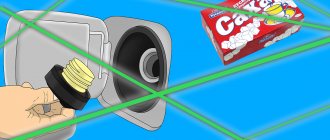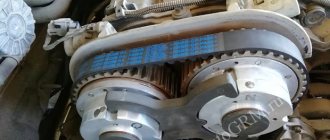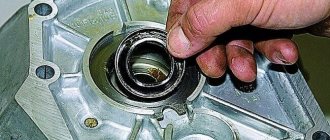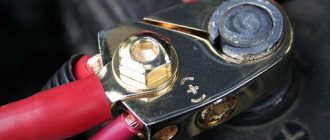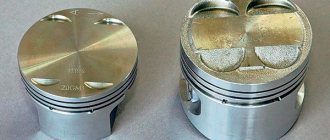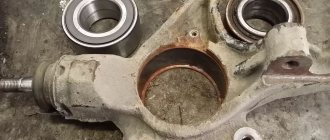Many car owners do not see a problem if there is water in the car’s gas tank. As a rule, it is present in small quantities, and therefore almost no one pays attention to this phenomenon. But, as practice shows, if there is water in the gas tank, the consequences can be unpredictable. In most cases, this contributes to the appearance of corrosion on metal surfaces. But there are often situations when, due to the presence of excess fluid, some components and devices of the power unit stop working. Therefore, you need to immediately get rid of water in the gas tank as soon as it appears, before it leads to incorrect operation.
If this is not done in a timely manner, you need to be prepared for the fact that the effects of water in the gas tank will certainly lead to contamination of the fuel supply devices in the gasoline engine. As for diesel power units, the presence of moisture in the fuel contributes to the incorrect operation of the fuel injection pump, because it damages the plunger pair. To prevent such problems, you need to know where the water in the gas tank comes from, what the symptoms of this phenomenon are and how to eliminate it.
Water in gasoline
As you know, water and gasoline do not mix, no matter how much you shake it.
It is heavier, and therefore always “sinks”: the boundary between the liquids is clearly visible. As you know, water and gasoline do not mix, no matter how much you shake it. It is heavier, and therefore always “sinks”: the boundary between the liquids is clearly visible.
Our task is to manage to mix water with gasoline, so that then it all burns in the cylinders and burns out in the neutralizer. We came across seven drugs with suitable descriptions - there is plenty to choose from. This is what we'll do.
We chose the following test method. 200 ml of gasoline and 2 ml of water were poured into tared containers - a concentration of 1% was obtained. This is quite a lot: half a liter of water equivalent to a 50-liter gas tank! Now we recalculate the dose of the drug proposed by the manufacturers for our gas tank in miniature. For drugs that indicate concentrations with a large spread (say, 40–80 liters), we take the maximum dose - so that the manufacturer does not say that it was deliberately “sunk”. As a result, the dose amount was, according to our estimates, from 1 to 2.8 ml. Now shake the container and see if the boundary between the liquids is preserved?
Prevention measures
Finally, I will give you some simple but useful tips that will help prevent such a phenomenon as the accumulation of water in the fuel tank of your car.
There is nothing complicated here. Just follow these guidelines:
- avoid unfamiliar and questionable gas stations;
- try not to open the tank lid unless necessary;
- screw the lid tightly;
- do not fill small amounts of fuel at gas stations;
- if the weather is humid, always fill the tank as full as possible;
- change the filter on time;
- in the autumn, you can add about 200 ml of alcohol to your full tank;
- Periodically (preferably in the fall), remove the tank, clean and dry it.
Water in gasoline
At first we were modest, carefully recalculating the declared volume of processed fuel in relation to the capacity of the chemical test vessels.
And only then did it dawn on us that things weren’t going to work that way. At first we were modest, carefully recalculating the declared volume of processed fuel in relation to the capacity of the chemical test vessels. And only then did it dawn on us that things weren’t going to work that way.
And then we realized that the experiment failed at the very beginning! None of the tested products turned the benzine-water mixture into a homogeneous liquid. A double increase in concentration also did not change the situation: in all cases, something bubble-like was floating on the bottoms of our containers, not wanting to completely “dissolve in the crowd.” This contradicted the assurances of numerous publications on the Internet - but what did we do wrong?
Ways to get moisture into the gas tank
There are many reasons why water condensation accumulates at the bottom of the filling tank, but the main way is the natural process of condensation of moisture contained in the atmospheric air. The gas tank, although it is a closed container, cannot be called completely sealed. This means that air enters it freely along with water, but the return path is open only to air. For this reason, the humidity in the fuel tank is always high (compared to the outside air), which leads to moisture condensation on the walls of the tank, from where it flows to the bottom under the influence of gravity without mixing with the fuel.
The habit (or rather, a vital necessity) of filling the tank with small portions of fuel, 5, maximum 10 liters, contributes to faster accumulation of water. At the turn of day and night, which is characterized by a sharp change in temperature, the process of condensation of water vapor occurs as intensely as possible. The more air in the filling container, the more moisture. Therefore, the best way to prevent water from entering the gas tank is to try to keep it filled with fuel at all times.
The second common reason for water getting into the refueling tank is refueling with low-quality fuel. Unscrupulous owners of gas stations, especially medium and small ones, take such steps as diluting gasoline/diesel fuel in order to increase their profits. At large network gas stations, this phenomenon occurs much less frequently and is solely due to the fault of the technical staff. If you are sure that the water that got into gasoline is the result of human factors, add this gas station to the “black list”: there is a high probability that the same thing happens at all gas stations of this brand.
Water can enter the gas tank and through the filler neck if you refuel in bad weather, and the gas station is not well protected from rain or snow falling on the car.
Finally, an even more exotic reason could be the deliberate actions of your enemies or random hooligans (provided that the fuel tank flap can be opened from the outside).
It would be useful to know the symptoms of water in gasoline:
- difficulties starting the engine, especially in the cold season;
- the power unit operates intermittently, especially when the accelerator pedal is pressed sharply;
- loss of engine throttle response, noticeable deterioration in acceleration dynamics.
In all these cases, it can be assumed that there is an abnormal amount of water in the gas tank that needs to be disposed of urgently, and here’s why.
Water in gasoline
At a low concentration of the drug, the water turns into this bubble at the bottom.
It will burn in the cylinders, but to turn it invisible, the concentration of the product must be much higher. In short, pour the entire bottle into the tank and that’s it. At a low concentration of the drug, the water turns into this bubble at the bottom. It will burn in the cylinders, but to turn it invisible, the concentration of the product must be much higher. In short, pour the entire bottle into the tank and that’s it.
I had to call one of the manufacturing companies (let me not disclose the name, otherwise they will be accused of hidden advertising), invite a normal engineer (not a PR person) to answer the phone and repeat the question: what did we do wrong?
- It's like that! - said the engineer. “You just expected in vain that under the conditions you specified, this same bubble would disappear somewhere.” Its task is not to disappear, but to burn along with gasoline. In this case, the density does not have to be equal to gasoline. However, if desired, you can achieve its complete dissolution, but for this the concentration of the drug must be much higher.
Symptoms of car “disease” with water
How to remove water from a gas tank is the main question of our article.
Difficulty starting the engine is the first symptom
So, the symptoms of “poisoning” your car. The first is difficulty starting the engine. When you get behind the wheel in the morning and feel that your iron horse does not want to start at half a turn, then the result of such a hitch may be water. After spending the night in the gas tank, water settles to the bottom and prevents the engine from working normally. The second is uneven engine operation. After the car has difficulty starting, the engine begins to behave strangely. This is worth paying attention to. Third is the slow operation of the engine. You may notice that the car is picking up speed with great effort, which means that a pest has probably gotten into your gas tank - water.
Liqui Moly Fuel Protect, Germany
Liqui Moly Fuel Protect, Germany
Liqui Moly Fuel Protect, Germany
Anti-ice fuel additive
approximate cost
435 rub.
Required concentration
300 ml per 60 l
The most expensive of the tested drugs in terms of cost per volume of fuel processed: approximately 7.25 rubles/l.
Methods for removing moisture from a gas tank
In fact, the symptoms of water in the fuel described above are also typical for many other problems in the operation of the power unit, so this phenomenon should be judged by a combination of symptoms. And if you are absolutely sure that the motor is failing because of this, you need to urgently take appropriate measures.
Now we will describe what to do if there is water in the gasoline tank. There are many ways to combat this phenomenon, some of them are extremely simple and can be done in just a few minutes. Others will require a lot of experience and skills from you. But in any case, this work can and should be done independently, without resorting to the services of a car service.
Mechanical methods for ridding a gas tank of water
The most radical, time-consuming and effective way to remove moisture from a gas tank is to dismantle it. It is highly recommended that there be a minimum amount of fuel in the tank at the time of work. The main problem is the complexity of the procedure for dismantling the filling tank, and different brands and models have their own characteristics regarding the location of the tank and ease of access to connecting pipes and other equipment. But by removing the gas tank, you can make it pristinely clean by removing all the contents from it, thoroughly rinsing and drying it. Handling the tank requires caution, since gasoline vapors will in any case pose a certain danger.
Those who did not go to school for show should remember the law of communicating vessels. However, it is also well known to notorious losers, since this educational material is usually accompanied by visual experiences and experiments. It turns out that it also applies to solving our problem. To separate gasoline from water and get rid of the latter, a long thin polyethylene flexible tube or rubber hose is enough. One end is inserted into the gas tank (it is important to make sure that it reaches the bottom), the second is lowered below the level of the filling tank. All that is required of you is to create sufficient vacuum in the hose to force the liquid located at the bottom of the container to drain out. Since water is heavier than fuel, the end of the process should coincide with the appearance of pure gasoline instead of water or a water-gasoline mixture. To perform this procedure, it is not necessary to drive onto an overpass or inspection hole.
Pump pumping is another effective method, used mainly on vehicles equipped with injection engines. Its essence is to remove the seat to gain access to the fuel pump. We dismantle the hose going from it to the injector, put another hose on the fitting, the free end of which is brought out. Turn on the ignition, and the fuel pump will automatically start. It is important that the tank is almost empty at the time of the procedure. It may not be possible to drain all the water at once, then you need to wait a minute and turn on the ignition again.
Using special products to remove moisture
In fact, the problem is as old as the car itself. It is not surprising that such inventive people as motorists have come up with many ways to remove excess moisture, which have been successfully used for more than half a century.
So, we will describe proven folk methods of how to remove water from gasoline. To do this, you can use alcohol, acetone or petroleum solvent.
Let's start with acetone - it used to be an affordable and very common product used as a solvent. It is flammable and has an octane number higher than gasoline. It is enough to add about 220 - 250 ml of acetone to a full or almost full gas tank. Being heavier than the fuel, it will sink to the bottom. Unlike gasoline, it mixes well with water, delivering this mixture to the combustion chamber, where acetone is burned and water is removed through the exhaust system.
Acetone
Since acetone can destroy plastic and rubber products, its frequent use is not recommended. It is important to maintain the specified proportion - in this case, this technical fluid will not be able to harm the fuel line and rubber gaskets.
Instead of acetone, you can use a solvent, which is not so aggressive and has similar physicochemical characteristics. 30 - 40 liters of gasoline require the same amount of this flammable substance.
If you use alcohol, you will need to dissolve at least 300 ml, otherwise the procedure is completely identical. The only disadvantage of using alcohol is its deficiency. Pharmacies sell diluted (usually 70%) medical alcohol, which itself contains a considerable amount of water, so it is not advisable to use such a liquid.
If you have access to pure technical, methyl or isopropyl alcohol, it is better to use it - when burned, it produces less non-combustible waste than solvent or acetone.
Note that methyl alcohol is a toxic substance, and it is very volatile. This means that you can be poisoned by simply inhaling the vapor of such a liquid, so you need to work with such alcohol with extreme caution.
The use of additives in fuel
The market for automotive additives is very large. There are even several classifiers of such additives used in relation to motor/transmission oils, gasoline/diesel oil and even antifreeze. But we are interested in additives designed specifically to remove water from fuel. They are popularly called fuel dryers (sometimes with the prefix “winter”).
The composition of such a moisture remover from a gas tank is quite diverse. These are ether and multifunctional surfactants, aliphatic alcohols and solvents. The composition and proportions of additives may vary among different manufacturers, but in any case, petroleum solvent is used as a base.
The principle of operation of fuel additives of this type is practically no different from using pure solvent, alcohol or acetone, but here the composition is selected on a strictly scientific basis, and you can be sure that the use of such an additive will not harm your car, and the displacement of moisture from the gas tank will happen much more efficiently. But the cost of such products significantly exceeds the price of alcohol, not to mention acetone.
As you can see, there is no shortage of means and methods for removing water from fuel. We have introduced you only to the simplest, safest and most commonly used of the many available. The choice is yours. And remember that this procedure is recommended to be performed annually, preferably before the start of the season of intensive use of the vehicle.
https://www.youtube.com/watch?v=HeMpbBlBzmU
Water Remover Agat Silverline Avto, Russia
Water Remover Agat Silverline Avto, Russia
Water Remover Agat Silverline Avto, Russia
Fuel system water cleaner
approximate cost
170 rub.
Required concentration
495 ml per 40–80 l
The cost of processing is approximately 4.25 rubles/l. Champion in frost resistance: in the freezer it beats the rest by a little more than a degree.
Why is moisture in a filling container dangerous?
Many motorists believe that the presence of water condensation in the fuel tank is normal. Indeed, it is in principle impossible to completely and permanently clear a tank of water, just as it is impossible to expect zero humidity from atmospheric air. However, a large accumulation of water condensate at the bottom of the tank cannot be called normal. What are the dangers of gasoline, abundantly diluted with water?
We have already mentioned that diesel and injection engines are considered the most susceptible to water. Moisture causes the greatest harm during periods of negative temperatures, when even a small amount of H2O can clog the fuel line, completely or partially preventing fuel from entering the injection system. Big troubles also await injector nozzles, where the technical holes have a microscopic diameter. A tiny amount of moisture is enough to disrupt the operation of the capricious injection system of diesel power units. Placing the car in a heated box will help solve the problem, but only partially, since thawed water risks ending up in the engine, which can lead to no less trouble.
The presence of water impurities in the fuel also affects the correct operation of the engine - due to changes in the physical characteristics of the fuel assembly, it will operate extremely unstably, with floating speeds and dips. This will be especially noticeable when driving on a road full of irregularities - the car will twitch. The idle speed will also be unstable.
Finally, we should not forget that the appearance of corrosion on the metal surfaces of parts included in the fuel system is also a consequence of water getting into gasoline. Most often, the fuel pump is susceptible to corrosion, the quality of the air-fuel mixture depends on its uninterrupted operation.
So the presence of a large amount of moisture in the gas tank should definitely be considered a negative factor that you should try to avoid.
